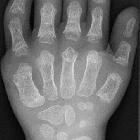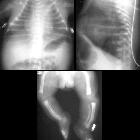osteochondrodysplasia
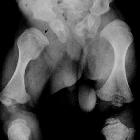

Skeletal
dysplasia • Short rib polydactyly syndrome - Ganzer Fall bei Radiopaedia

X-ray of a
24-year-old American man, who had suffered more than one hundred bone fractures in his lifetime, and received a childhood clinical diagnosis of type IVB OI. Genetic diagnosis in 2018 identified a previously uncatalogued pathogenic variant in the gene which encodes proα2(I) chains of type I procollagen, COL1A2, at exon 19, substitution c.974G>A. Due to childhood neglect and poverty, subject never received surgery to implant intramedullary rods. Malunions are evident as the humerus and femur were broken in adolescence but orthopedic care did not follow. Severe scoliosis, as well as kyphosis, are also evident. The unavoidably low contrast in the film is due to a combination of subject"s obesity and low bone mineral density (BMD). Subject"s BMD Z-score was -4.1 according to results of a dual-energy X-ray absorptiometry (DXA) scan also done in 2018. This X-ray is of the left forearm and also shows most of the left upper arm and part of the left hand.

Osteogenesis
imperfecta • Osteogenesis imperfecta - Ganzer Fall bei Radiopaedia
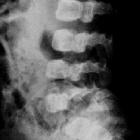
lateral X-rax
of lumbar spine in Kniest-Dysplasia showing coronal vertebral clefts

Fig. 259.—
Chondrodystrophia. Adult case. Wide sudden expanding of ends of bones. Short stubby shafts. No bowing in the bones affected. (Original.)Identifier: americanpractice01brya (find matches)Title: American practice of surgery : a complete system of the science and art of surgeryYear: 1906 (1900s)Authors: Bryant, Joseph D. (Joseph Decatur), 1845-1914 Buck, Albert H. (Albert Henry), 1842-1922Subjects: Publisher: New York : W. Wood and companyContributing Library: University of California LibrariesDigitizing Sponsor: Internet ArchiveView Book Page: Book ViewerAbout This Book: Catalog EntryView All Images: All Images From Book Click here to view book online to see this illustration in context in a browseable online version of this book.Note About Images Please note that these images are extracted from scanned page images that may have been digitally enhanced for readability - coloration and appearance of these illustrations may not perfectly resemble the original work.


Identifier:
diseasesofchildr00grah (find matches)Title: Diseases of childrenYear: 1916 (1910s)Authors: Graham, Edwin Eldon, b. 1864Subjects: Children DiseasePublisher: Philadelphia and New York, Lea & FebigerContributing Library: Columbia University LibrariesDigitizing Sponsor: Open Knowledge CommonsView Book Page: Book ViewerAbout This Book: Catalog EntryView All Images: All Images From Book Click here to view book online to see this illustration in context in a browseable online version of this book.Text Appearing Before Image:normal. As a rule, however, they develop slowly, are late in talking,and behind the normal child in acquiring knowledge. The deformityin the sacral region and pelvis caused by defective ossification of theinnominate bones may make normal labor difficult and necessitate theuse of forceps, or, possibly, the performance of Cesarean section. Diagnosis.—The condition has been confounded with hydrocephalus,rickets, and cretinism; but careful examination will invariably resultin a correct diagnosis. X-ray plates will show the short and curvedbones of the arms and legs, and will aid in the recognition of the disease. Prognosis.—The general nutrition of the infant is affected, as isevident from the poor ligamentous and muscular development. Manyof the, children die during birth, or, owing to poor development, soonafterward; others, as has been stated, may live to extreme old age.They marry and have children, and their offspring may either showachondroplasia or be absolutely normal. PLATE IText Appearing After Image:Achondroplasia. ^r^slTf?^r.f^^^^^^l ^f^ ^^ epiphyses with ^.ery short shafts. TheTZs Ina the th h ° proportion than the trunk. The upper feg^ below ;het?eel proportionately shorter than the forearn^s an/lhe CHAPTER VIII.INFANT FEEDING. Cows Milk.—The infant may be fed on cows, goats or asss milk,but as the milk of the cow is almost always obtainable, and that ofthe ass and goat is often difficult to procure, cows milk is, for practicalpurposes, the one which is universally adopted in the United States. Our first thoughts in regard to cows milk should be of the cowsand the farm. The herd should be healthy and free from any taintof tuberculosis. They should be properly fed both in and outside ofthe barn, and care should be taken to see that the pasture fields do notcontain weeds and rank growths. The cows should be carefullygroomed, given an abundance of fresh air and fresh water, and themanure should be removed from the barn as frequently as possible. The milkers should be clean, anNote About Images Please note that these images are extracted from scanned page images that may have been digitally enhanced for readability - coloration and appearance of these illustrations may not perfectly resemble the original work.


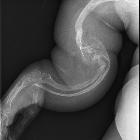
X-ray of a
24-year-old man clinically diagnosed with Type IVB OI. Genetic diagnosis in 2018 resulted in no identifiable type, but identified a previously uncataloged pathogenic variant in the gene which encodes proα2(I) chains of type I procollagen, COL1A2, at exon 19, c.974G>A. Due to childhood neglect, subject never received rodding surgeries, and there is also evidence the femur was broken and not set properly in a hospital, causing a malunion. Severe scoliosis is also evident. The unavoidably low contrast in the film is due to a combination of subject"s obesity and poor bone density.

Skeletal
dysplasia • Jeune syndrome - Ganzer Fall bei Radiopaedia

X-ray of a
24-year-old man clinically diagnosed with Type IVB OI. Genetic diagnosis in 2018 resulted in no identifiable type, but identified a previously uncataloged pathogenic variant in the gene which encodes proα2(I) chains of type I procollagen, COL1A2, at exon 19, c.974G>A. Due to childhood neglect, subject never received rodding surgeries, and there is also evidence the femur was broken and not set properly in a hospital, causing a malunion. Severe scoliosis is also evident. The unavoidably low contrast in the film is due to a combination of subject"s obesity and poor bone density.

X-ray of a
24-year-old man clinically diagnosed with Type IVB OI. Genetic diagnosis in 2018 resulted in no identifiable type, but identified a previously uncataloged pathogenic variant in the gene which encodes proα2(I) chains of type I procollagen, COL1A2, at exon 19, c.974G>A. Due to childhood neglect, subject never received rodding surgeries, and there is also evidence the femur was broken and not set properly in a hospital, causing a malunion. Severe scoliosis is also evident. The unavoidably low contrast in the film is due to a combination of subject"s obesity and poor bone density.

editX-rays of
a full term neonate boy who was found to have crackles from the chest. Later genetic testing revealed osteogenesis imperfecta type 5. Vertebrae and ribs... ...with multiple rib fractures Right leg, with somewhat deformed long bones (mainly the femur) with widened metaphyses There is also a cortical fracture on the fibula Left leg. Left arm... ...with a periosteal reaction indicating a fracture. Right arm

Macrocephaly
• Achondroplasia - Ganzer Fall bei Radiopaedia

Sclerosing
bone dysplasia (overview) • Pyle disease - Ganzer Fall bei Radiopaedia

Skeletal
dysplasia • Diastrophic dysplasia - Ganzer Fall bei Radiopaedia

Skeletal
dysplasia • Thanatophoric dysplasia - Ganzer Fall bei Radiopaedia

Skeletal
dysplasia • Chondrodysplasia punctata - Ganzer Fall bei Radiopaedia

Chondroectodermal
dysplasia • Ellis-van Creveld syndrome - Ganzer Fall bei Radiopaedia

Thanatophoric
dysplasia • Thanatophoric dysplasia - Ganzer Fall bei Radiopaedia
The term osteochondrodysplasia is usually used synonymously with skeletal dysplasia, and merely means a dysplasia involving bone and cartilage.
These conditions typically affect collagen metabolism, and often found as part of a skeletal dysplasia syndrome (e.g. Cantu sydnrome). As such the term osteochondrodysplasia should not be used as a specific diagnosis.
Siehe auch:
- Osteogenesis imperfecta
- Rhizomelie
- Achondroplasie
- asphyxierende Thoraxdysplasie (Jeune-Syndrom)
- Ellis-van-Creveld-Syndrom
- Chondrodysplasia punctata
- Thanatophore Dysplasie
- Diastrophische Dysplasie
- chondroectodermal dysplasia
- Camurati-Engelmann-Syndrom
- Kniest-Syndrom
- short limb skeletal dysplasias
- camptomelic dysplasia
- lethal skeletal dysplasias
- Achondrogenesie
- Pyle-Syndrom
- Atelosteogenesis
- Osteoglophone Dysplasie
- sclerosing
und weiter:
- Polydaktylie
- Kleidokraniale Dysplasie
- Skoliose
- Kniest-Dysplasie
- short limb skeletal dysplasia
- Klumpfuß
- nuchal translucency
- intraspinale zystische Läsionen
- Tibiaverbiegung bei Kindern
- Intrauterine Wachstumsretardierung
- congenital syndromes associated with enlarged ventricles
- postaxiale Polydaktylie
- Verbiegung der langen Röhrenknochen
- paediatric curriculum
- mesoectodermal dysplasia
- Larsen-Syndrom
- Kurzripp-Polydaktylie-Syndrome
- Stüve-Wiedemann-Syndrom
- Kabuki-Syndrom
- koronare Wirbelspalten
- generalized increased bone density in paediatrics
- shortened fetal long bones
- small for date fetus
- shortened fetal femoral length
- sklerosierende Knochendysplasien
- acromesomele Dysplasie Maroteaux-Typ
- fetal limb bowing
- Osebold-Remondini-Syndrom
- Schwartz-Jampel syndrome
- camptomelic dwarfism
- fetal skeletal dysplasia
- fetal nuchal oedema
- Hypochondrogenesie
- metatrophic dysplasia
- Blomstrand osteochondrodysplasia
- fetale Rippenfrakturen

 Assoziationen und Differentialdiagnosen zu Skelettdysplasie:
Assoziationen und Differentialdiagnosen zu Skelettdysplasie:






